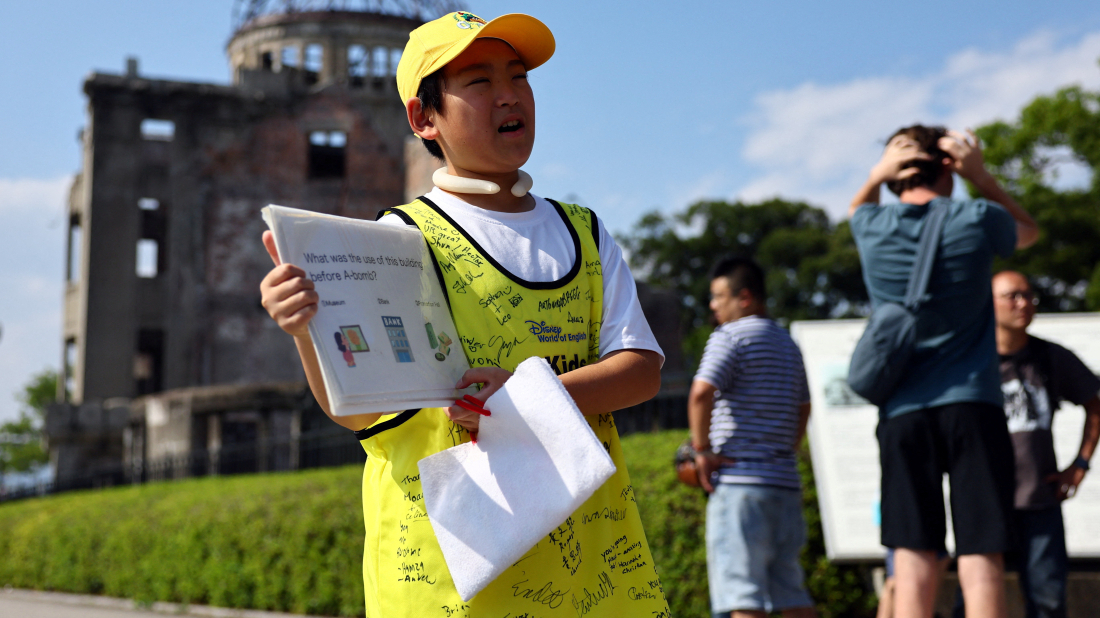UN to make 'tough, brutal choices' as it cuts its aid appeal to $23 billion for 2026
Tens of millions of people in urgent need of help won't be getting much assistance next year. That's according to the United Nations which launched a ...

Twelve-year-old Shun Sasaki walks the paths of Hiroshima Peace Memorial Park with quiet determination, guiding tourists from around the world through the city’s scarred past in the hope of preserving its memory.
Since the age of seven, Shun has been offering free English-language tours of the park, wearing a yellow vest with the message "Please feel free to talk to me in English!" across the back.
His mission is simple: to ensure the horrors of nuclear war are never forgotten.
“I want them to come to Hiroshima and know about what happened at Hiroshima on August 6,” he said in English, speaking ahead of the upcoming 80th anniversary of the atomic bombing. “I want them to know how bad is war and how good is peace. Like... instead of fighting, we should talk to each other about the good things of each other.”
The experience is deeply personal.
Shun’s great-grandmother, Yuriko Sasaki, was a 'hibakusha' — a survivor of the atomic bomb. At the time of the blast in 1945, she was a young girl, just 1.5 kilometers from the hypocentre.
Their house collapsed in the explosion, and Yuriko was buried under debris.
“She was not burnt, but she was affected by the radiation,” Shun’s grandfather, Kazuyoshi Sasaki, recalled.
Yuriko lived until the age of 69, having survived breast cancer and later dying of colorectal cancer in 2002.
Shun, who has guided about 2,000 visitors, prepares for each tour by flipping through old photographs with his grandfather, learning and retelling the story of his family's survival.
He leads visitors past the Atomic Bomb Dome, the Peace Bell, and monuments scattered across the park, handing out folded paper cranes—a traditional Japanese symbol of peace.
“To hear that about his family, his mother, his grandmother, his great-grandmother was a survivor, it surely wrapped it up, brought it home, and made it much more personal. So it was outstanding for him to share that,” said Chris Lowe, a Canadian tourist who joined one of Shun’s tours. “Twelve years old, what he is doing is amazing. The kid is outstanding, well-spoken, very thoughtful. So, I highly commend him for what he is doing. It’s amazing. It really is.”
This year, Shun has been selected as one of two children to speak at the city’s official commemoration ceremony on August 6—a major event marking eight decades since the bombing.
For him, continuing these tours is a long-term goal. “The most dangerous thing is to forget what happened long time ago… so I think we should pass the story to the next generation and then never forget it, ever again,” he said.
On August 6, 1945, at 8:15 a.m., an American B‑29 bomber dropped a uranium‑235 bomb, nicknamed “Little Boy”, over Hiroshima.
The blast instantly killed around 78,000 people, and by the end of 1945, the death toll had risen to approximately 140,000, due to radiation exposure and injuries.
Three days later, on August 9, the United States dropped a second bomb—“Fat Man”, a plutonium‑239 weapon—on Nagasaki.
A coup attempt by a “small group of soldiers” has been foiled in Benin after hours of gunfire struck parts of the economic capital Cotonou, officials said on Sunday.
A delayed local vote in the rural Honduran town of San Antonio de Flores has become a pivotal moment in the country’s tightest presidential contest, with both campaigns watching its results as counting stretches into a second week.
FIFA releases the 2026 World Cup schedule with match dates, venues, and key fixtures. See when host nations USA, Mexico, and Canada play and get an overview of group stage and knockout rounds.
Lava fountains shot from Hawaii’s Kīlauea volcano from dawn to dusk on Saturday, with new footage showing intensifying activity at the north vent.
McLaren’s Lando Norris became Formula One world champion for the first time in Abu Dhabi, edging Max Verstappen to the title by just two points after a tense season finale.
Tens of millions of people in urgent need of help won't be getting much assistance next year. That's according to the United Nations which launched a $23 billion aid appeal on Monday (8 December) which is half of last year's request, acknowledging a plunge in donor funding.
Emergency crews were deployed to the northeastern Ukrainian city of Okhtyrka on Monday morning after a residential high-rise was devastated by a Russian drone barrage, leaving several civilians wounded as the conflict approaches the end of its fourth year.
Nigerian authorities says they've rescued a 100 children after gunmen abducted 303 pupils and 12 teachers from a Catholic school in Papiri on 21 November.
Following a high-level meeting of the Communist Party leadership on Monday, state media confirmed that China will seek to insulate its economy from external volatility by turning inward, pledging to "keep expanding domestic demand" through a suite of "more proactive" policies.
Start your day informed with AnewZ Morning Brief: here are the top news stories for the 8th of December, covering the latest developments you need to know.
You can download the AnewZ application from Play Store and the App Store.

What is your opinion on this topic?
Leave the first comment